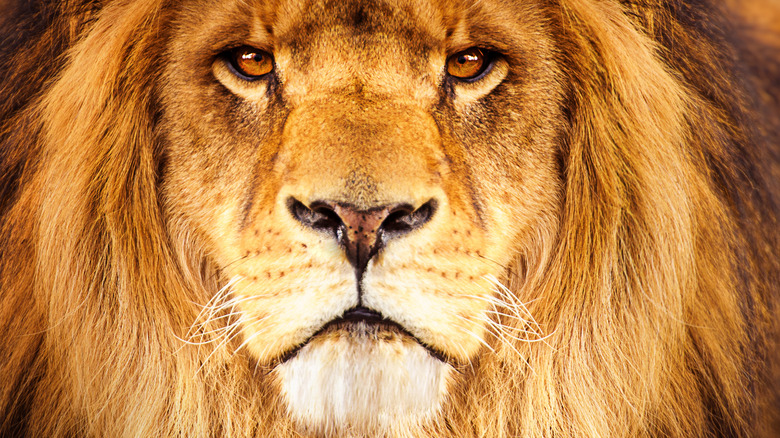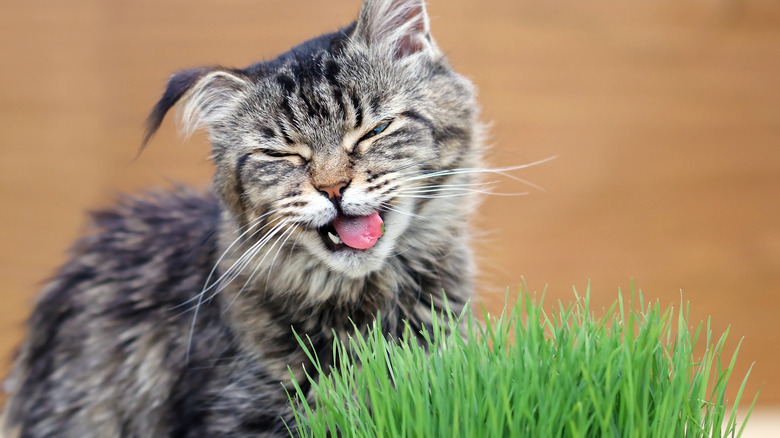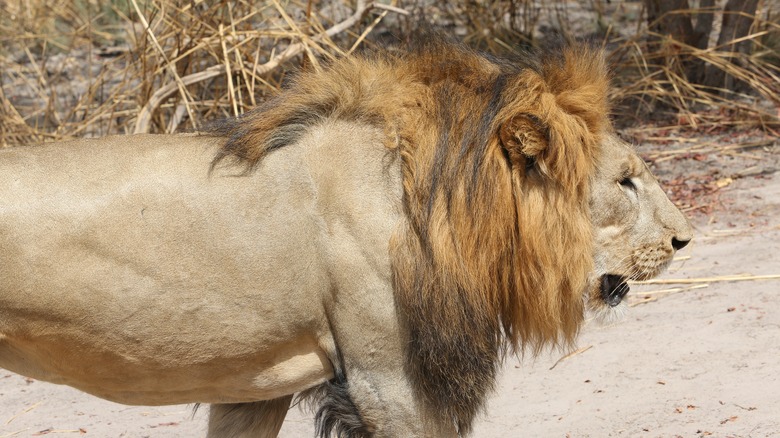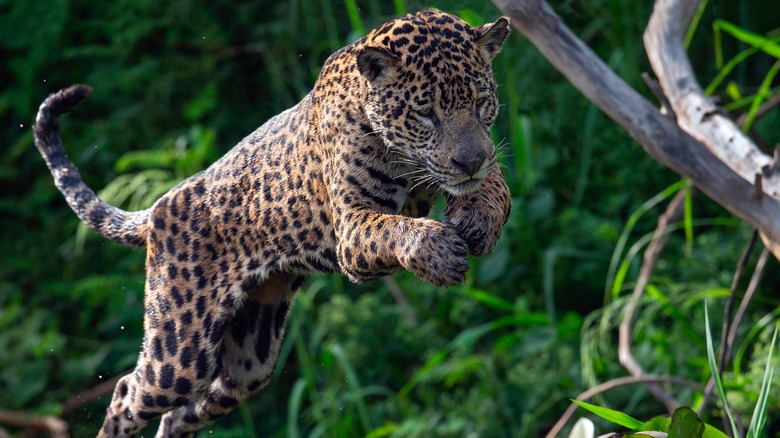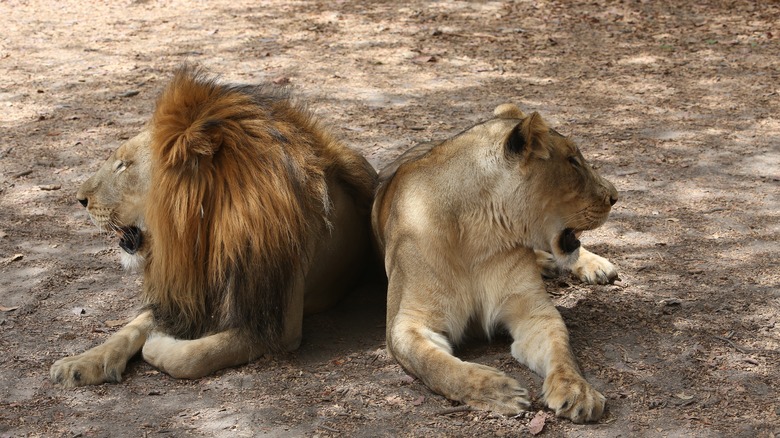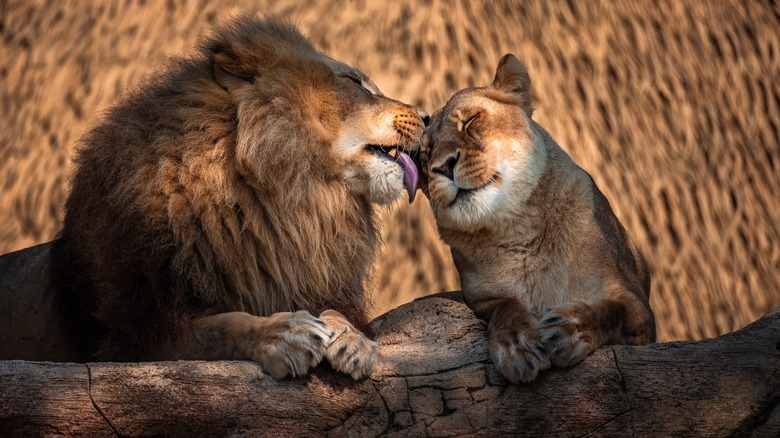What Would Happen If You Gave Lions And Jaguars Catnip?
Catnip, as many a cat will tell you, is certainly a tempting prospect. So much so, in fact, that the word has come to be used for anything that acts as a strong lure for a certain individual or group. As Britannica reports, the herb has a range of uses. Its powerful aroma is believed to be effective in teas to help relieve the symptoms of colds and similar ailments, and it is sometimes added to food. Most importantly, though, our feline friends don't seem to be able to resist it.
In the abstract of the study "The characteristic response of domestic cats to plant iridoids allows them to gain chemical defense against mosquitos" (via Science Advances), Reiko Uenoyama et al explain that "Domestic cats and other felids rub their faces and heads against catnip (Nepeta cataria) and silver vine (Actinidia polygama) and roll on the ground as a characteristic response." This, according to the team's research, is a reaction to the iridoid nepetalactol, which "increased plasma β-endorphin levels in cats." By rubbing said nepetalactol on themselves, it seems, such "self-anointing behavior helps to protect cats against mosquito bites." Many pet owners have surely seen such behavior first-hand, but it seems that big cats also have fascinating reactions to catnip.
Jacob's organ is the key to catnip's appeal
Cats Protection states that the plant is not a culinary treat for cats, but an olfactory one. Like dogs, they have very keen senses of smell, and the scent of the plant is impossible for some kitties to resist.
Like other mammals (as well as reptiles and amphibians, per Britannica), cats have an organ known as Jacobson's organ in the region of the roof of the mouth. Cats Protection relates that cats flood that area with the powerful scent of the catnip by using their tongues. Needless to say, not all cats go wild for catnip, so this reaction will differ, but it can be truly remarkable to see the distances some cats will go to in an attempt to get their paws on it.
But what of cats with much larger paws? Big cats, you might think, have more serious business to attend to than chasing laser dots across the carpet, surreptitiously using expensive wooden furniture as a scratching post, and all the usual favorite pastimes of domestic cats. As it turns out, though, some of the world's biggest feline species have been known to revel in catnip just like their smaller brethren.
The mystery of catnip and big cats
As Mental Floss reports, a study in the 1970s sought to determine how strongly different species of big cat would react to catnip. The research took place at the Knoxville Zoological Park, where catnip extract and the plant itself was provided to 33 big cats.
The cheetahs didn't respond to the catnip in the slightest, according to the report, while the tigers interacted with it a bit more but didn't seem to be particularly enamored by it. The jaguars and lions seemed the most interested, per Mental Floss.
According to the abstract of the study "Species-characteristic responses to catnip by undomesticated felids," published by J.O. Hill in April 1976 (via Springer Link), a total of six species were included in the research, and its findings debunked several theories about catnip. For instance, it does not only appeal to female cats, and certainly not only to the smaller species that millions around the world have invited into their families.
Big, playful kitties?
J.O. Hill et al write (via Springer Link) that catnip "elicits a predictably "playful" behavior pattern apparently independent of experience and learning" in pet cats. Essentially, it encourages them to cut loose and be a little silly, even if they're typically far too serious for such shenanigans.
It's difficult to imagine big cats, some of the largest and most powerful predators in the world, as "playful." They're magnificent, fearsome and formidable creatures, often providing some of the most harrowing segments of wildlife shows in pursuit of their lunch.
Despite this, the study noted that "play (which is defined here as the interaction between individuals demonstrating such behaviors as biting, pawing, jumping and rolling over)" was noted among several of the species. The catnip was introduced in a variety of ways, being sprayed on objects and concealed behind panels, but it appealed to at least some of the animals in every case.
A species' geographical origins may have an influence
Why did the results differ by animal? Perhaps the most interesting conclusion drawn from the experiments was that some species would be familiar with catnip in the wild, while others would not.
The study, per Springer Link, states that some species that live alongside the plant in the wild, such as bobcats, didn't seem interested in it at all during the experiments. By contrast, it's reported that "lions and jaguars would not ordinarily encounter catnip (which is endemic to North America and Europe, but not to the Southern Hemispheres)," but were some of the most reactive to it.
It's possible, then, that some of the curious cats were investigating something entirely new in their environment, or there could be an evolutionary factor, as all the animals involved had been born in captivity and had no experience of the wild. Mature animals that were neither very young nor very old also had stronger reactions overall.
Bigs cats can still be kittens at heart
Mental Floss adds that another curious difference between big and domestic cats' responses was the amount of time they'd interact with it for in one "sitting." Those that enjoyed the catnip most would do so for around an hour, while a quarter of an hour is a common time for pet cats to do so.
The big cats that were strongly drawn to the catnip exhibited behaviors rather typical of domestic house cats: They rolled on it, rubbed themselves against it, and otherwise delighted in its presence.
It's always remarkable to see likenesses between the behaviors of big cats and domestic cats, the former having such a fearsome reputation. In 2013, Guinness World Records declared the largest living cat to be the lion and tigress hybrid Hercules, who weighed in at 922 lb (418.2 kg) and was 3.33 meters (nearly 11 feet) long. Regardless of their size, though, it seems that cats will be cats: They'll jump in and love that catnip or silver vine, or they won't, at their own discretion, and they won't care a jot if eager scientists are watching.
